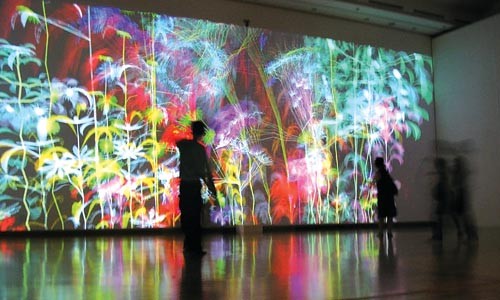Miguel Chevalier has been exploring technology as an artistic medium since 1982. Yet his work acquires a new significance in 2006, as we attempt to navigate through this increasingly digitized world: one in which computers have infiltrated nearly every aspect of our lives.
At Wood Street Galleries, Paris-based Chevalier exhibits "Ultra-Nature," an interactive virtual-reality installation, and "RGB Land," a computer-generated landscape. Known internationally as one of the pioneers of computer-based art, Chevalier has recently exhibited in Morocco, Shanghai, Buenos Aires, Oslo, Paris, Brussels and Seoul.
Chevalier studied traditional fine art in Paris and New York, and cites as influences artists as diverse as Monet, Moreau, Delacroix and the pointillist Seurat. In a 1999 interview with Patrick Imbard (which can be found at www.miguel-chevalier.com), Chevalier noted that the pointillists' experimentation with brushstroke and "simultaneous contrast of color" neatly mirrors a process in electronic art: The juxtaposition of pixels on a computer screen creates color and form just like setting one brushstroke beside another in a painting.
Believing that avant-garde painters had explored all possible avenues of representation, Chevalier held that digital technology could revolutionize art: Unlike other, more static art forms, it can present the artwork in "real time."
This concept is at the core of these two nature-themed works. "Ultra-Nature" is a virtual garden created with software by Music2Eye. Eight varieties of plants projected on a long gallery wall "grow" in real time, in a never-repeating cycle and, that is theoretically, infinitely.
The plants develop at various speeds and have different "life cycles." Ranging from bright yellow flowers to red and green succulents, the vegetation has an inherently un-organic, architectural quality. Most of the plants seem almost translucent, like ghostly doppelgängers to their counterparts in nature.
The work, at 118 feet long, is projected in three sections. Although "Ultra-Nature" was first shown at the Sejul gallery, in Seoul, the blue background to the digital garden is unique to the Wood Street version, and this is the first time the work has been shown in America.
On his Web site, Chevalier cites Monet's "Waterlilies" as an influence; the artist created panoramic scenes by placing large canvases end-to-end. Chevalier endeavors to transform this idea for a contemporary audience. Via numerous motion sensors and a complex computer program, the viewer is able to influence the growth and movement of the plants. For example, by leaning to the left, the viewer causes the same movement in the flora. With its endless permutations, Chevalier's ephemeral and transient garden is perfect artifice: The work operates like nature, albeit entirely disconnected from the organic world.
Yet the ease with which we can alter the plant's movement through our own is somewhat unsettling. Perhaps this speaks, metaphorically, to the larger question of how our very existence alters the natural world.
"RGB Land," meanwhile, was created in collaboration with Eric Wenger. Also wall-projected to about 100 feet long, it is a desert landscape that appears to move steadily toward the viewer. Seen as if from a bird's-eye view, the panorama in red, green and blue is on an eight-minute loop. Unlike "Ultra-Nature," this work is not interactive. Rather, the algorithms and fractal models of the "computer map" have created the landscape.
Recently, Chevalier stated that the program ran for nearly three months in order to develop this eight minutes of "RGB Land." As we stand in front of it, this enormous, unpopulated landscape becomes disconcerting: We know it is not real, yet the feeling of being overwhelmed by the beauty and grandeur of nature is eerily authentic. It is as if the sublime that Caspar David Friedrich and Albert Bierstadt so desperately aimed to capture through paint has, ironically, been recreated most convincingly by technology.
Ultra-Nature continues through Dec. 31. Wood Street Galleries, 601 Wood St., Downtown. 412-471-5605 or www.woodstreetgalleries.org















